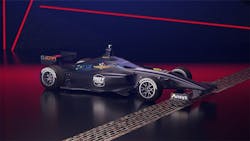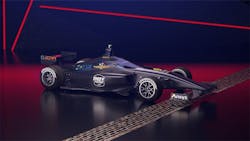Engineering AVs to Race at the Indianapolis Motor Speedway
>> Electronic Design Resources
.. >> Top Stories of the Week
.. .. >> CES 2021
What you will learn:
- At CES, the Indianapolis Motor Speedway and Energy Systems Network unveiled details of an autonomous car race to be held at the famous racetrack on October 23.
- University teams are developing software for specially modified Dallara IL-15 race cars
- The race will be 20 laps around the famous venue and the winning team will take home $1 million.
When, in 1953, Wilbur Shaw first gave the starting call of "Gentlemen, start your engines!" at the Indianapolis Motor Speedway (since updated to “Ladies and Gentlemen” for the years when female drivers are competing), no one could have anticipated that the brickyard would host a race where starting the engine would be the last human-controlled action in the event. But that’s exactly what will happen on October 23.
At CES, the Indianapolis Motor Speedway (IMS) and Energy Systems Network (ESN) released details of the Indy Autonomous Challenge (IAC), a $1.5 million prize competition among universities to program autonomous modified Dallara IL-15 cars to compete in a race. Check out the press conference:
The minute that car is on the track, it must control itself entirely. This is the world’s first head-to-head autonomous car race at speeds of up to 200 mph around the famed track.
The winning team’s car must complete 20 laps around the 2.5-mile Indianapolis Motor Speedway track for a total of 50 miles.
The primary organizers, ESN and IMS, are supported by a consortium of public and private partners and sponsors. Collaborators include ADLINK, Ansys, Aptiv, AutonomouStuff, Bridgestone, Clemson University’s International Center for Automotive Research (CU-ICAR), Microsoft, New Eagle, PWR, RTI, Schaeffler, and Valvoline. Also involved are the Indiana Economic Development Corp. and the aforementioned Dallara, producer of the modified IL-15 car that each team will use.
The goal of the challenge, according to the organizers, is to advance technology that can speed the commercialization of fully autonomous vehicles and deployments of advanced driver-assistance systems (ADAS). Such enhancements will lead to increased safety and performance in all modes of racing and commercial transportation.
The IAC is a competition among accredited tax-exempt universities worldwide to create software that enables automated-capable race cars to compete and finish first in a head-to-head race on the famed oval. The competition centers around software. When designing software, the teams are really trying to mimic the way that a human race driver will be driving the car.
Teams will not be asked to develop and produce automated vehicle computers, sensors, and other hardware. Instead, the focus is on developing new generations of software that can ensure precision control of vehicles at high speeds during the competition and reduce fatalities on public roadways afterwards.
Clemson’s “Deep Orange”
The modified Dallara IL-15 race car has been retrofitted with hardware and controls by Clemson University Deep Orange 12 (DO12) students to enable automation. Since 2001, Dallara has been the sole supplier of race-car chassis for the Indy Lights Series, whose main goal is to prepare young drivers for the NTT Indycar series.
Clemson University’s students are tasked with determining the sensor types and locations to provide the vehicle with computer vision at high speeds. Technologies under consideration include, but aren’t limited to, radars, LiDARs, cameras, and GPS sensors. Integration of these sensors on the vehicle is a difficult challenge since vibration levels may be high and the presence of sensors will influence the vehicle’s aerodynamics.
Graduate students on Clemson University’s Deep Orange 12 team also will determine the appropriate internal combustion powertrain. This will provide the sustained power levels required for racing at high speeds and generate the electrical power needed for onboard computing and sensing systems.
Company-Provided Donations
Aptiv, an IAC Vehicle Sponsor, will provide radar technologies for the IAC’s vehicles. ADLINK Technology is the edge -omputing sponsor and equips university teams with AI devices, technical resources, and engineering support for in-vehicle computing and validation. The modified Dallara IL-15 IAC race cars are fitted with donated ADLINK AVA-3501/DLAP-800X robot controllers with Nvidia RTX graphics processing unit (GPU) AI acceleration and central processing units to run IAC teams’ software and algorithms in the race car.
At 180 mph (290 kmh) on the straightaway (80 meters per second), a 20-Hz LiDAR must calculate four meters per point cloud—the 3D model of the area surrounding the race car—which can include distortion due to movement. Cameras must capture 60 images per second, which is greater than 1 meter per image. Add data-processing latency, and you get a small taste of the problems that must be solved.
Engineering simulation software suppler Ansys has created a simulation platform based on its VRXPERIENCE Driving Simulator, powered by SCANeR, that’s embedded around the IMS track and in the modified Dallara IL-15 vehicle models. Ansys is providing all registered teams with this platform along with its SCADE software-development suites, to allow the teams to develop and test their autonomous-vehicle software in a virtual environment.
Ansys also will conduct sessions to train all students in the simulation solutions and will implement and execute a simulation race, scheduled for May 2021, awarding a $150,000 prize to the top finisher of the simulation race.
Students from 37 universities have registered to compete in the IAC. Some have joined forces to collaborate. This is a global challenge with universities from 11 countries on four continents, including 14 U.S. states. The IAC teams are encouraged to secure their own sponsorships.

